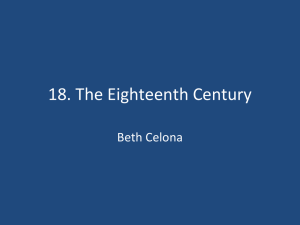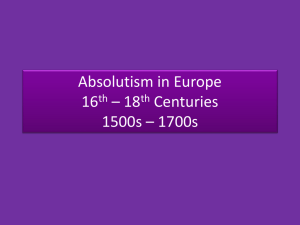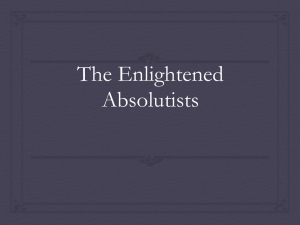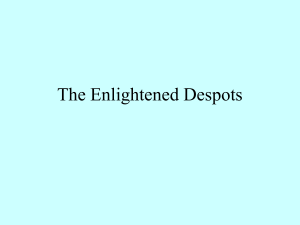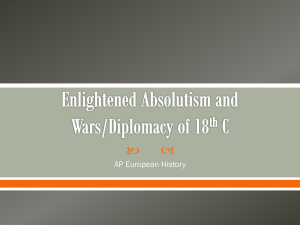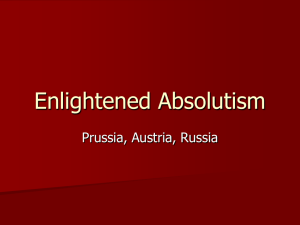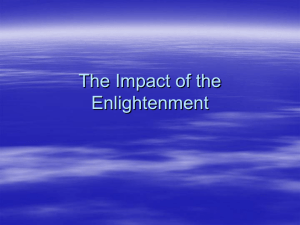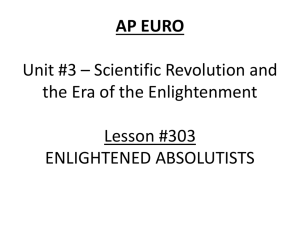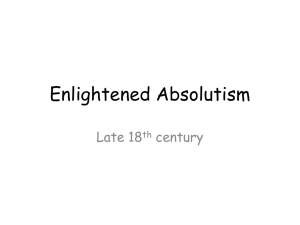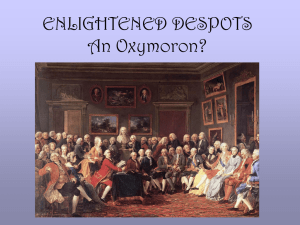englightenmened despots
advertisement
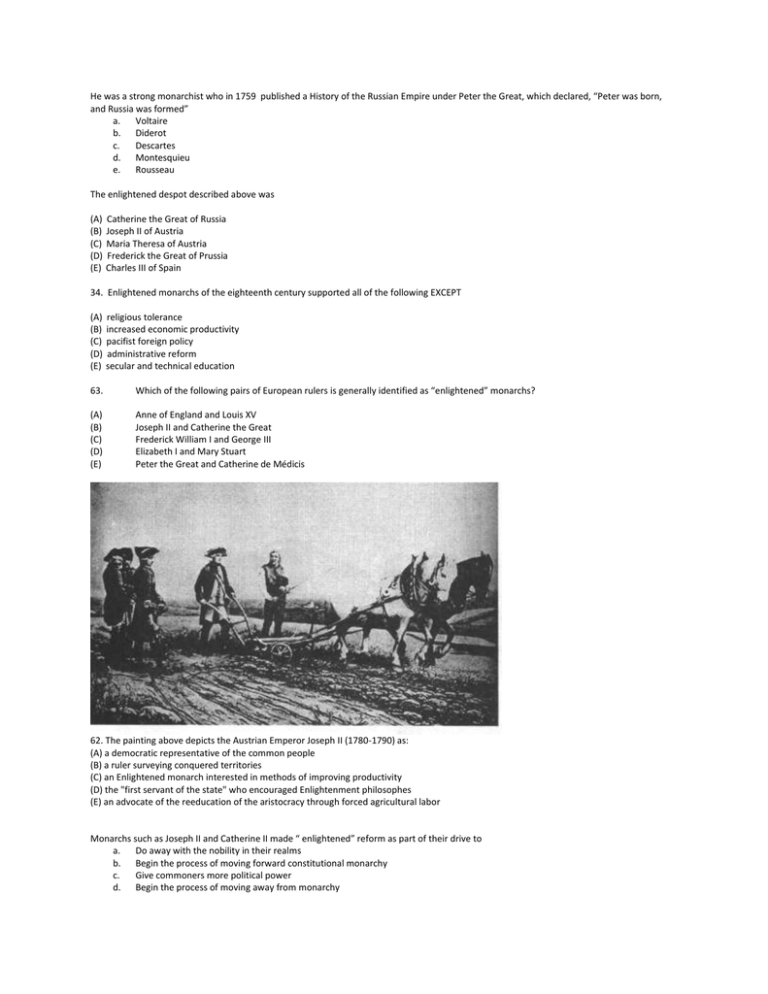
He was a strong monarchist who in 1759 published a History of the Russian Empire under Peter the Great, which declared, “Peter was born, and Russia was formed” a. Voltaire b. Diderot c. Descartes d. Montesquieu e. Rousseau The enlightened despot described above was (A) (B) (C) (D) (E) Catherine the Great of Russia Joseph II of Austria Maria Theresa of Austria Frederick the Great of Prussia Charles III of Spain 34. Enlightened monarchs of the eighteenth century supported all of the following EXCEPT (A) (B) (C) (D) (E) religious tolerance increased economic productivity pacifist foreign policy administrative reform secular and technical education 63. Which of the following pairs of European rulers is generally identified as “enlightened” monarchs? (A) (B) (C) (D) (E) Anne of England and Louis XV Joseph II and Catherine the Great Frederick William I and George III Elizabeth I and Mary Stuart Peter the Great and Catherine de Médicis 62. The painting above depicts the Austrian Emperor Joseph II (1780-1790) as: (A) a democratic representative of the common people (B) a ruler surveying conquered territories (C) an Enlightened monarch interested in methods of improving productivity (D) the "first servant of the state" who encouraged Enlightenment philosophes (E) an advocate of the reeducation of the aristocracy through forced agricultural labor Monarchs such as Joseph II and Catherine II made “ enlightened” reform as part of their drive to a. Do away with the nobility in their realms b. Begin the process of moving forward constitutional monarchy c. Give commoners more political power d. Begin the process of moving away from monarchy e. Increase revenues and gain political support This monarch embodies enlightened enlightened absolutism more than any other . He/she forged a state that commanded the loyalty of the military, the junker nobility, the Lutheran clergy , and a growing bureaucracy a. Joseph II b. Catherine II c. Maria Theresa d. Peter the Great e. Frederick the Great Monarchs associated with enlightened with enlightened absolutism included all of the following EXCEPT a. Louis XIV b. Joseph II c. Maria Theresa d. Frederick the Great e. Catherine II Of all the rising states of the 18th century, this state what the most diverse in its people and problems a. France b. Prussia c. Russia d. Britain e. Austria Maria Theresa of Austria did all of the following EXCEPT a. Expanded primary education b. Created central councils to deal with political problems c. Limited the amount of labor the nobility could demand form peasants d. Created regional legislative councils to give ordinary people a say in politics e. Established a very efficient tax system Joseph II of Austria a. Extended freedom of worship to Muslims b. Increased the tax burden on the peasantry c. Built many Catholic seminaries and allowed the church total autonomy d. Sought to improve the productivity and social conditions of the peasantry e. Reduced the serfs to slaves Catherine the Great of Russia a. Abandoned the ideals of absolutism b. Built a strong alliance with the nobility c. Made an alliance with Poland d. Replaced the nobles with loyal government bureaucrats e. Freed Russian serfs As part of her territorial aspirations, Catherine the Great painlessly annexed this newly independent state in 1783 a. Estonia b. Livonia c. Crimea d. Finland e. Romania The most important reason absolute monarchs like Catherine II and Frederick II attempted reform was a. Because they believed in the Enlightenment b. To strengthen their states c. To improve the lot of their serfs d. To gain the respect of the philosophes e. Because they wanted to show off their power to other monarchs Joseph II of Austria(1780-1790) has been called the “ideal Enlightened Despot” for all of the following reasons EXCEPT a. He abolished serfdom b. He fostered freedom of the press c. He granted religious freedom to most Christian sects and to Jews d. He abolished the secret police e. He suppressed the influence of the Roman Catholic Church Catherine the Great was somewhat limited in the enlightenment reforms she could initiate mainly because a. She was female b. She was fearful after the violence of Pugachev’s Rebellion c. Russia was a large, backward country d. She was more interested in conquest e. Russian law was cumbersome and difficult A fact that was true of both Frederick the Great of Prussia and Joseph II of Austria was that a. Both decreed total religious toleration b. Both closed monasteries dedicated to prayer and meditation c. Both freed serfs d. Neither imporved education e. Neither trained a successor Which best characterized Enlightened Despotism a. The monarch is an educated person who exercises absolute authority solely as he sees fit b. The monarch encourages the spread of Deism and rationalism c. The monarch supports and fosters the growth of democracy d. The monarch rules with absolute authority for the good of the people e. The monarch believes in the people’s ultimate right to, and capacity for, self-rule Which of the following was generally not considered an Enlightened Despot a. Frederick the Great of Prussia b. Peter the Great of Russia c. Catherine the Great of Russian d. Maria Theresa of Austria e. Alexander the Great of Russia f. Frederick II of Prussia proved himself an enlightened monarch in all of the following ways EXCEPT a. Introducing new crops and scientific agriculture b. Hosting Voltaire at Potsdam c. Composing music for the flute d. Establishing total religious toleration e. Eliminating torture and establishing appellate courts Any ambition that Catherine the Great may have had to reform serfdom in Russia fell by the wayside after a. Didierot visited her in Russia b. Pugachev staged his rebellion in 1773-1774 c. She met with delegated to consider codifying Russian law d. She got involved with the partitions of Poland e. She was preoccupied with her various lovers Which of the following statements is most accurate for those rulers in the 18th century who are labeled Enlightened Despots a. They under cut the basis of monarchical authority b. They did not under stand many of the nuances of Englightenment Absolutists c. They implemented serious reforms that had long-term consequences for their countries d. Their toyed with the ideas of reform but refused to put limits on their royal prerogatives e. The made their nations into more rational constitutional monarchies
